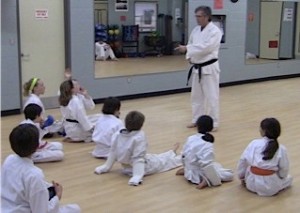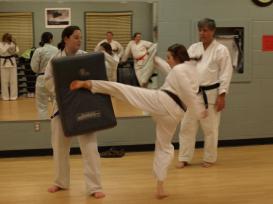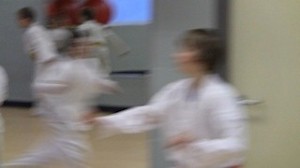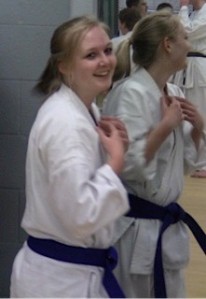 Several years ago in my role as a part-time karate instructor, I got run down from too many competing interests for my time. My business required a great deal of travel, my daughters had very active lives and my karate classes had expanded to nine hours and three nights from just one, two-hour evening. But I carried on as usual, somewhat aware of the toll it was taking on me.
Several years ago in my role as a part-time karate instructor, I got run down from too many competing interests for my time. My business required a great deal of travel, my daughters had very active lives and my karate classes had expanded to nine hours and three nights from just one, two-hour evening. But I carried on as usual, somewhat aware of the toll it was taking on me.
However, as I was an experienced instructor, I was convinced I could leave it all behind and shift to the Zone at class time and pull off what I thought were some pretty amazing classes. So why worry?
During this time of struggle, I encountered a karate student and his father in the YMCA parking lot as they were heading out and I was arriving. I attempted a quick shift to my normal Zone for the conversation and was shocked that it was so difficult. It was as though my internal “Zone” engines were sputtering but refusing to start.
“Going to figure skating,” I heard, and “He’s quitting skating because he is bored.” With the word “bored,” perhaps because I was currently working with some figure skaters, I finally mustered enough energy to say, “You’re quitting figure skating when you have all those Olympic role models in your club?!” “You are my role model,” the boy said, and those words seemed to hang in the air a long time. Good-bye, I said as they drove off, now unsure if I deserved that honor.
The following week, prior to class, nothing much had changed except for a lot of thinking, and I sprawled out on the couch to rest before heading to my class. Instead of watching TV, I watched a 45-minute karate video of Japanese karate champions doing their katas or forms that a student had given to me to review. The athletes were fast and powerful and I thought their style might offer me some new insights for myself as both competitor and instructor. And that was all…I thought…just an instructional video.
But that wasn’t all! On my way to the Y afterwards I was driving just a bit faster than  usual. And at the Y there was lightness in my step. And there was an unexplained electricity in my core, before I even stepped on the dojo floor. And in front of the class I felt wired and fluid. And at the end of the evening, students rushed up to me drenched in sweat. “The class was fantastic,” one said. “We need to do it like this more often,” another added.
usual. And at the Y there was lightness in my step. And there was an unexplained electricity in my core, before I even stepped on the dojo floor. And in front of the class I felt wired and fluid. And at the end of the evening, students rushed up to me drenched in sweat. “The class was fantastic,” one said. “We need to do it like this more often,” another added.
Mirror neurons kicking into action
So what was different from this class and that of the previous week? The video! It must have triggered my mirror neurons and allowed me to copy (model) the Japanese champions. What exactly are mirror neurons? They represent a part of the brain that allows us to interpret body language and social signals, to feel empathy with others and, yes, to learn (click on this link to read a TED blog on the subject: http://bit.ly/1u5OIZD). My mirror neurons must have kicked into action and allowed me to mirror the energy, posture and even the dynamic skill of the karate champions I had observed in the video. I was pumped, literally.
Immersed in a sea of learning.
My youngest karate students have demonstrated this process to me time and again, as they  always came back from competitions much improved. Initially I was troubled that they were just goofing off and playing tag in the bleachers between matches, but I realized that their mirror-neurons were being stimulated continuously by the whole tournament experience—even if they looked distracted.
always came back from competitions much improved. Initially I was troubled that they were just goofing off and playing tag in the bleachers between matches, but I realized that their mirror-neurons were being stimulated continuously by the whole tournament experience—even if they looked distracted.
They were immersed in a sea of athletes and instructors who were thinking, breathing and walking karate. And once they were back in my class, they brought what they learned with them and displayed skills that they didn’t even know they had learned. They moved differently, performed their katas with more finesse and fought more intuitively.
Kicking your own mirror neurons into action
And yes, you have mirror neurons too. Mostly they work subconsciously, where you see an action and subconsciously copy it such as me watching the video and my students immersed in the tournament. You can observe this process by how you cross your legs or arms when you are in a group, right after someone else does. This subconsciously-driven process can seem funny when you notice how often it happens.
action and subconsciously copy it such as me watching the video and my students immersed in the tournament. You can observe this process by how you cross your legs or arms when you are in a group, right after someone else does. This subconsciously-driven process can seem funny when you notice how often it happens.
I am going to guess that most of you may have experienced mirror neurons already in your sport. However, as our attitudes and beliefs can prevent our motor neurons from fully “turning on,” it can be useful to learn to control the process. Here are some things you can do to activate them:
- Watch only the best. YouTube offers videos in just about every sport, which is especially useful for those whose sports are televised only in Olympic years. As you watch athletes perform (or coaches if you are a coach), you may even feel the movements of your muscles as the mirroring process takes hold. Let that happen as it means it is working.
- As you practice, pretend you are your favorite athlete or coach. Pick a skill you want to learn and pick an athlete you want to learn it from. Then imagine that athlete standing beside you so you can move over and step “into their shoes.” See if you can feel their posture and energy. And then go experience the change in your game.
- Step into the shoes of your athletes. If you are a coach, such as a golf, teaching pro, step into the shoes of your athletes so that you can identify where they are going wrong. Most coaches do this intuitively, but if you are new to coaching, learn to use your mirror neurons more effectively as they are your best ally. You’ll actually feel where your athletes are going off track and be able to help them.
- Teach your athletes how to anticipate their opponents. As a coach, you can also teach your athletes to “size up” their opponents by having them imagine stepping into the shoes of opposing goaltenders (hockey, soccer), pitchers (baseball, cricket) or quarterbacks (football). This process can reveal some amazing weaknesses in the opponents.
Summary
With these simple suggestions, you can be in control of your mirror neurons and the mirroring process, so that you can learn just about anything—in sport, work and school. Still to this day I can step into my high-intensity, Japanese-champion frame of mind, just as one would put on a pair of shoes. You can do it too. And, oh yes, the best competitors offer the best shoes, so choose your role models wisely.

These insights are spot on ! Michael Hebron PGA HALL of FAME
LikeLike